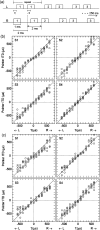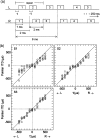Lateralization of noise-burst trains based on onset and ongoing interaural delays
- PMID: 20649227
- PMCID: PMC2921432
- DOI: 10.1121/1.3436560
Lateralization of noise-burst trains based on onset and ongoing interaural delays
Abstract
The lateralization of 250-ms trains of brief noise bursts was measured using an acoustic pointing technique. Stimuli were designed to assess the contribution of the interaural time delay (ITD) of the onset binaural burst relative to that of the ITDs in the ongoing part of the train. Lateralization was measured by listeners' adjustments of the ITD of a pointer stimulus, a 50-ms burst of noise, to match the lateral position of the target train. Results confirmed previous reports of lateralization dominance by the onset burst under conditions in which the train is composed of frozen tokens and the ongoing part contains multiple ambiguous interaural delays. In contrast, lateralization of ongoing trains in which fresh noise tokens were used for each set of two alternating (left-leading/right-leading) binaural pairs followed the ITD of the first pair in each set, regardless of the ITD of the onset burst of the entire stimulus and even when the onset burst was removed by gradual gating. This clear lateralization of a long-duration stimulus with ambiguous interaural delay cues suggests precedence mechanisms that involve not only the interaural cues at the beginning of a sound, but also the pattern of cues within an ongoing sound.
Figures










Similar articles
-
Strength of onset and ongoing cues in judgments of lateral position.J Acoust Soc Am. 2017 Jul;142(1):206. doi: 10.1121/1.4990020. J Acoust Soc Am. 2017. PMID: 28764482 Free PMC article.
-
Onset dominance in lateralization.J Acoust Soc Am. 1997 Mar;101(3):1649-59. doi: 10.1121/1.418149. J Acoust Soc Am. 1997. PMID: 9069632
-
Lateralization and detection of pulse trains with alternating interaural time delays.J Acoust Soc Am. 2002 Oct;112(4):1605-16. doi: 10.1121/1.1504859. J Acoust Soc Am. 2002. PMID: 12398466
-
Temporal weighting of binaural cues revealed by detection of dynamic interaural differences in high-rate Gabor click trains.J Acoust Soc Am. 2010 May;127(5):3092-103. doi: 10.1121/1.3377088. J Acoust Soc Am. 2010. PMID: 21117758 Free PMC article.
-
Sensitivity to interaural level and envelope time differences of two bilateral cochlear implant listeners using clinical sound processors.Ear Hear. 2004 Oct;25(5):488-500. doi: 10.1097/01.aud.0000145124.85517.e8. Ear Hear. 2004. PMID: 15599195
Cited by
-
Threshold of the precedence effect in noise.J Acoust Soc Am. 2014 May;135(5):2923-30. doi: 10.1121/1.4869682. J Acoust Soc Am. 2014. PMID: 24815272 Free PMC article.
-
Effects of forward masking on sound localization in cats: basic findings with broadband maskers.J Neurophysiol. 2013 Oct;110(7):1600-10. doi: 10.1152/jn.00255.2013. Epub 2013 Jul 10. J Neurophysiol. 2013. PMID: 23843432 Free PMC article.
-
The impact of peripheral mechanisms on the precedence effect.J Acoust Soc Am. 2019 Jul;146(1):425. doi: 10.1121/1.5116680. J Acoust Soc Am. 2019. PMID: 31370612 Free PMC article.
-
Strength of onset and ongoing cues in judgments of lateral position.J Acoust Soc Am. 2017 Jul;142(1):206. doi: 10.1121/1.4990020. J Acoust Soc Am. 2017. PMID: 28764482 Free PMC article.
-
The effect of an additional reflection in a precedence effect experiment.J Acoust Soc Am. 2012 Apr;131(4):2958-67. doi: 10.1121/1.3689849. J Acoust Soc Am. 2012. PMID: 22501073 Free PMC article.
References
-
- Braasch, J., and Blauert, J. (2003). “The precedence effect for noise bursts of different bandwidths. II. Comparison of model algorithms,” Acoust. Sci. & Tech. 24, 293–303.10.1250/ast.24.293 - DOI
-
- Braasch, J., Blauert, J., and Djelani, T. (2003). “The precedence effect for noise bursts of different bandwidths. I. Psychoacoustical data,” Acoust. Sci. & Tech. 24, 233–241.10.1250/ast.24.233 - DOI
Publication types
MeSH terms
Grants and funding
LinkOut - more resources
Full Text Sources
Medical

